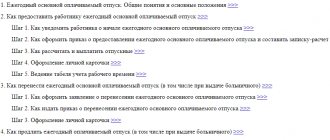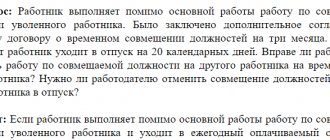Is vacation allowed when working part-time?
Part-time work is considered to be the implementation by a person of additional paid labor activity within the framework of an employment contract.
Moreover, it must differ from his activities at his main place of work and be performed during non-working hours (Article 282 of the Labor Code of the Russian Federation). The contract must specify that this work is a part-time job. The legislation does not contain rules to limit the number of such works, but there can only be one main one. In this case, the employee can take a part-time job with his main employer or find others. In the 1st case, part-time work will be considered internal, and in the 2nd - external.
Important! Not all employees are allowed to work in this mode. The Labor Code of the Russian Federation prohibits part-time work for minors and employees whose activities at their main and additional places of work are associated with dangerous and harmful working conditions (Article 282 of the Labor Code of the Russian Federation). Or if their duties are related to the management of vehicles and their movement (Article 329 of the Labor Code of the Russian Federation). There are also restrictions for employees of internal affairs bodies and lawyers.
In addition, the legislation contains clarifications regarding part-time work for workers in the fields of education, culture, medicine and pharmaceuticals (Resolution of the Ministry of Labor of the Russian Federation dated June 30, 2003 No. 41).
When working part-time, the employee is entitled to the same guarantees and compensations as at his main place of work. They can be wider if this is provided for by the provisions of internal documents and acts in force in each specific company.
However, some guarantees and compensation can only be obtained at the main place of work, for example, taking study leave or receiving benefits and compensation when working in the Far North and equivalent territories.
Read about the procedure for calculating and paying maternity benefits for part-time workers in our article “Maternity benefits for part-time workers.”
The Labor Code of the Russian Federation clearly defines the number of working hours both at the main place of work and at the additional one. Based on its provisions, with a part-time job, an employee has the right to work no more than 4 hours a day. Note that this norm applies for each employment contract separately (Article 284 of the Labor Code of the Russian Federation). Consequently, each employer maintains its own records of hours worked within the framework of the concluded employment contract.
A part-time worker can work a full working day when he is not busy at his main place of work. These may be weekends and holidays or days of forced rest (for example, if the employer has delayed payment of wages for 15 days or more or the employee’s health condition does not allow him to perform his job duties).
Important! In a month (or other accounting period), a part-time worker must work no more than half of the standard working hours provided for his category.
For part-time workers employed in the fields of education, culture, medicine and pharmaceuticals, the permitted work time depends on their category and can range from 16 hours to the monthly norm (Resolution No. 41).
Yes, part-time workers are also entitled to paid days off, like all workers (Part 1 of Article 115 of the Labor Code of the Russian Federation). At the same time, so that a person can truly relax from the heart, days off for a part-time worker are necessarily given at the same time and of the same duration as at his main place of activity. This is directly provided for by the Labor Code of the Russian Federation, Article 286.
Even if an employee works in several organizations, he arranges rest days for himself everywhere at the same time, and none of the employers can refuse him. And all because rest is not only the right of working citizens, but also, oddly enough, their responsibility, which allows employers to count on a fully functioning team, and not exhausted barge haulers from the famous painting by Repin.
Internal part-time work and the problem of vacations
An employee of the enterprise works at his main place of work and on an internal part-time basis. When going on vacation, he writes a statement only for his main place of work; he refuses to write a part-time job, citing the fact that he is doing the work without even being at the workplace. As a result, vacation is accrued only at the main place of work.
Tell me, is the employee right and what consequences may arise for the company?
Art. 282 Labor Code of the Russian Federation
It has been established that
part
-time work is the performance by an employee of another regular paid job under the terms of an employment contract
in his free time from his main job
.
Part-time work can be performed by an employee both at the place of his main job and with other employers.
The employment contract must indicate that the job is a part-time job.
Art. 114 Labor Code of the Russian Federation
guarantees that
employees are provided with annual leave
while maintaining their place of work (position) and average earnings.
At the same time, according to Art. 286 Labor Code of the Russian Federation
Persons working part-time
are granted annual paid leave simultaneously with leave for their main job
.
If an employee has not worked for six months at a part-time job, then leave is granted in advance.
If in a part-time job the duration of the employee’s annual paid leave is less than the duration of leave at the main place of work, then the employer, at the request of the employee, provides him with leave without pay for the corresponding duration.
If you strictly follow the letter of the law, then an employee (including a part-time worker) should not write an application for leave at all
.
In accordance with Art. 122 Labor Code of the Russian Federation
paid leave must be provided to the employee annually.
The right to use vacation for the first year of work arises for the employee after six months of continuous work with this employer.
By agreement of the parties, paid leave may be granted to the employee before the expiration of six months.
Leave for the second and subsequent years of work can be granted at any time of the working year in accordance with the order of provision of annual paid leave
established by this employer.
The order of provision of paid vacations is determined annually in accordance with the vacation schedule
, approved by the employer, taking into account the opinion of the elected body of the primary trade union organization no later than two weeks before the start of the calendar year in the manner established by
Art.
372 of the Labor Code of the Russian Federation for the adoption of local regulations.
The vacation schedule is mandatory for both the employer and the employee
.
The employee must be notified of the start time of the vacation against signature no later than two weeks before its start.
(
Art. 123 Labor Code of the Russian Federation
).
That is, you had to approve the vacation schedule, providing for the simultaneous provision of vacation to the employee both for his main job and for part-time work
.
Then, two weeks before the vacation, you would simply familiarize the employee with the order to grant the vacation and no problems would arise.
Since the approved vacation schedule is mandatory for the employee, the employee does not have the right to unilaterally refuse to use vacation
.
Art. 106 Labor Code of the Russian Federation
It is established that
rest time
is the time during which the employee is free from performing work duties and which he can use at his own discretion.
Vacation is a type of rest time
(
Article 107 of the Labor Code of the Russian Federation
).
In letter dated 05/08/2009 No. 1248-6-1, Rostrud explained
that the work of persons working part-time has its own characteristics, the regulation of which is provided for
in Chapter 44 of the Labor Code of the Russian Federation
.
Features of labor regulation
- these are rules that partially limit the application of general rules on the same issues or provide additional rules for certain categories of workers.
Thus, a feature of the regulation of labor of persons working part-time is the norm of Art. 286 Labor Code of the Russian Federation
, according to which part-time workers are granted annual paid leave simultaneously with leave for their main job.
In general, the specificity of part-time work is that the conditions of such work are initially made dependent on the employee’s main job.
Hence the general approach to solving the problem: the employer for part-time work is obliged to take into account the employee’s main job - applying a special regime of work and rest for the employee, in particular, allowing an increase in the duration of leave (albeit by providing leave without pay).
The employer at the main place of work is limited only by the obligation to provide the employee with annual paid leave of a specified duration.
Providing annual paid leave to a part-time worker in another period (not simultaneously with leave for the main job), including at the request of the employee, does not guarantee the latter (employee) that he will be able to fully use annual paid leave in kind
.
In other words, while on leave from his main place of work, the employee will continue to work part-time and vice versa.
Considering the above, Rostrud believes that the employer does not have sufficient grounds
to provide annual paid leave to a part-time employee
not simultaneously with annual leave for the main job
.
Federal Law No. 139-FZ of July 1, 2010 ratified International Labor Organization Convention No. 132 on paid holidays
(revised in 1970), in force in Russia
since September 6, 2011
Art. Article 13 of the Convention provides that in each country special rules may be established by the competent authority or in any other prescribed manner in respect of cases where an employee, during the period of leave, engages in activities related to the generation of income and contrary to the purpose of the leave.
.
However, to date, no such special rules have been established in Russia.
.
Perhaps that is why Rostrud in 2013 outlined a different version: an employee has the right to work part-time while on leave from his main place of work
.
True, this was said in a private consultation
.
And the official position of Rostrud has not changed since 2009
.
The procedure for calculating vacation payments for a part-time worker
Vacation pay is calculated according to the general calculation rules. Must be issued to the employee at least 3 days before the start of the vacation.
To calculate the amount of vacation pay, you must:
- Calculate average earnings for the previous 12 full months. It is calculated based on the working hours worked according to the timesheet, taking into account all coefficients and allowances, if any.
- Then you need to determine the calculation period. As a rule, this is 12 months, if vacation is taken earlier than six months worked - 6 months. If some months in the period for calculation were not fully worked out, it is necessary to apply a special formula for incomplete periods: Number of days in incompletely worked out months = (Worked days according to the calendar x 29.3) / Total days according to the calendar)
- The average daily earnings are calculated:
- in simple situations: the total amount of average earnings is divided by 12 and then by the average of 29.3.
- in situations with periods that are not fully worked out, the total amount of earnings must be divided by the number of days calculated using a special formula: months fully worked out x 29.3 and add the calculated days based on the above formula.
- Multiplied by the number of vacation days, usually 28.
Not included in average earnings:
- non-contributory benefits;
- payments during periods of downtime of the organization;
- sick pay;
- maternity payments;
- retained wages;
- payments for business trips, compensation amounts for food, travel.
If an employee takes several additional vacation days at his own expense, the company does not pay him for these days.
Included in average earnings:
- bonuses provided for in the Regulations on Remuneration;
- all bonuses and coefficients;
- coefficient for indexing earnings at the enterprise;
- remuneration in kind and cash.
We suggest you read: Can a husband give his wife a plot of land purchased during marriage?
In one organization
An internal part-time worker is assigned a separate personnel number, and in all accounting documents - time sheets, staffing tables, he must appear twice: as the main employee and as a part-time worker, in order to ensure correct calculation of working hours and earnings.
Accordingly, vacation payments must also be calculated twice. And then sum it up.
Confirmation for granting leave to a part-time worker can be a document indicating the period of leave at the main place of work - for example, an extract from an order or a free-form certificate from the enterprise. The employee must independently notify his management about the need and timing of taking leave at his second place of work.
The certificate is drawn up according to the following sample.
Any employee may need a certificate of objective information. Read, what is a lens reference? The taxation system provides for special regimes. Which to choose?
How can a private person obtain a license to transport passengers? See the article.
In accordance with the law:
- calculation of payments in connection with an employee going on annual leave is carried out in a uniform manner, regardless of whether he carries out his main activity or works part-time, and is regulated by the Labor Code of the Russian Federation;
- the number of rest days is calculated in calendar days (usually twenty-eight calendar days for normal working conditions);
- the billing period does not include holidays that are official days off;
- the employee’s total calculated rest period is increased by the number of additional days (additional leave) provided for by law, which are included in the total calculation of vacation payments.
If an employee combines his main activity with an additional one for one employer, then calculating vacation pay does not cause any difficulties.
The total amount of payments for the vacation of an internal part-time employee consists of separately calculated amounts of payments of the main employee and part-time employee, which are calculated separately depending on the duration of each vacation period. In this case, the days that make up the difference between vacation periods are not subject to payment.
To calculate the amount of vacation payments for an external part-time worker, it is necessary to determine the average daily wage of a part-time employee, taking into account all the applicable allowances and coefficients that are payable to the main employees of a similar part-time position.
Vacation pay is transferred to the employee’s bank account or issued in cash three working days before he goes on vacation.
Study leave under the Labor Code of the Russian Federation: 5 rules for an accountant
Study leave is a leave for an employee who combines work with study. Under what conditions is the employer obliged to provide such leave? How to calculate and pay it correctly, including for part-time workers? Let's look at the rules and answer common questions
The employer is obliged to provide study leave to employees who work and receive education:
- higher education in bachelor's, specialist's or master's programs, as well as enrolling in these educational programs (Article 173 of the Labor Code of the Russian Federation);
- higher education - training of highly qualified personnel or are applicants for the academic degree of candidate or doctor of science (Article 173.1 of the Labor Code of the Russian Federation);
- secondary vocational education, and also enroll in this type of education (Article 174 of the Labor Code of the Russian Federation);
- basic general education or secondary general education through part-time and part-time education (Article 176 of the Labor Code of the Russian Federation).
Rule 2. Conditions for granting study leave - there are nuances
- Condition 1. Guarantees and compensations for employees combining work with education are provided upon receiving education at the appropriate level for the first time (Article 177 of the Labor Code of the Russian Federation).
The form of study (full-time, part-time, part-time) is not a condition for granting study leave, but affects its payment:
- If an employee is studying full-time, then study leave is not paid.
- If the course is full-time or part-time, then the average earnings are maintained for the period of study leave (Articles 173, 173.1, 174, 176 of the Labor Code of the Russian Federation).
Example. The employee has secondary vocational education (graduated from college). He decided to study at college in a different specialty - in this case, he cannot count on study leave again.
Guarantees and compensations are provided to employees who already have a professional education at the appropriate level and who have been sent by the employer to receive education in accordance with an employment contract or apprenticeship agreement concluded in writing between the employee and the employer.
- Condition 2. If an employee works and studies simultaneously in two organizations engaged in educational activities, guarantees and compensation are provided for one of these organizations (at the employee’s choice) (Article 177 of the Labor Code of the Russian Federation).
- Condition 3. The educational institution in which the employee is studying has state accreditation. The register of accredited educational organizations can be found on the website of the Federal Service for Supervision in Education and Science.
Exception: the employer has the right to grant study leave to an employee who is studying at an educational institution without state accreditation, if this is specified in the labor (collective) agreement.
- Condition 4. Study leave can be granted only on the basis of a summons certificate from an educational institution.
- Condition 5. Study leave is granted for a duration no longer than that specified in the Labor Code of the Russian Federation.
Exception: the employer can provide study leave of longer duration, provided that this is stipulated in the employment (collective) agreement.
- Condition 6 . Study leave is provided only at the main place of work (Article 287 of the Labor Code of the Russian Federation). During the session, a part-time worker must continue to work in his free time from studies or take leave without pay during this time (pay attention to rules 4 and 5).
Example. An employee has two jobs: permanent and part-time. He combines work with obtaining higher education. Study leave is allowed only for one place of work, for example, in the organization in which he works permanently.
The employee had a question: is it possible to undergo training and at the same time work in an organization that is a second place of work - part-time? An employee can contact the employer of the organization where he works part-time with a request to grant him leave at his own expense for the period of study.
The employer has the right to refuse the employee’s request, citing the fact that such a condition is not specified in the employment (collective agreement).
Rule 3. Registration of study leave. Procedure
- The employee turns to the employer with an application, to which is attached a certificate of summons from the educational institution.
- The manager issues an order (form No. T-6 or No. T-6a) to provide the employee with a guarantee.
- The accountant draws up a calculation note where the average earnings will be calculated.
- Data on study leave is recorded in the employee’s personal card (Form No. T-2), personal account (Form No. T-54 or No. T-54a) and in the working time sheet (Form No. T-12 or No. T-13).
Rule 4. Payment for study leave
Study leave should be correctly calculated and the resulting amount taken into account when calculating certain types of taxes, as well as insurance contributions to extra-budgetary funds.
Let's look at how to pay for and calculate study leave, which can be provided either with or without maintaining average earnings.
Example. An employee undergoes final state certification for a period of up to 4 months when receiving higher education in a bachelor’s program. During this period, he retains his average earnings.
But if an employee passes the entrance examination to such an educational institution, then the average salary is no longer paid.
The employee can only count on maintaining his place of work for the period of entrance examinations.
For more information about cases when the average salary should be paid and when not, we recommend that you look at Art. 173-176 Labor Code of the Russian Federation. It also lists other guarantees that an employee who combines work with training can count on.
For example, employees who successfully master state-accredited bachelor's degree programs, specialist programs or master's programs in part-time and part-time forms of study are given a working week shortened by 7 hours for a period of up to 10 academic months before the start of the state final certification.
Average earnings for the time an employee is on study leave are paid according to the rules of Decree of the Government of the Russian Federation dated December 24, 2007 No. 922.
Personal income tax should be withheld from the amount received and this amount should be included in the base for calculating insurance contributions to extra-budgetary funds of the Russian Federation. When calculating income tax, these amounts can be included in labor costs (Article 255 of the Tax Code of the Russian Federation).
Rule 5. Calculation of average earnings during study leave
The average salary for the time the employee is on study leave should be paid on time. A common question: “Do we make payments for study leave, just like for regular leave, 3 days before the leave?”
Yes, that’s right (Part 9 of Article 136 of the Labor Code of the Russian Federation, Letter of Rostrud dated July 30, 2014 No. 1693-1).
The employee must receive average earnings before the start of study leave. It is a mistake to pay the average salary after the employee brings a confirmation certificate.
You may have another question: what to do if the employee did not bring a confirmation certificate? In accounting, reversal entries should be made for the amount of average earnings paid to the employee before the start of the vacation.
Answers to common questions about study leave
Advanced training at Kontur.School
Take the online course “Payroll settlements with personnel”
View program
The employee wants to add the main leave to the study leave. Is it correct?
- The employee's request is unlawful. The issue of adding study leave to annual paid leave is resolved by agreement between the employer and the employee (Part 2 of Article 177 of the Labor Code of the Russian Federation).
Is it possible to partially use study leave?
- Study leave is a right, not an obligation, of an employee. The right to grant an employee educational leave of a specified duration is given, in particular, by a summons certificate, which, among other things, determines the terms of such leave. This follows from Part 4 of Art. 177 of the Labor Code of the Russian Federation, the form of the summons certificate approved by Order of the Ministry of Education and Science of Russia dated December 19, 2013 No. 1368. Accordingly, an employee can exercise his right to study leave only within the period specified in the summons certificate. However, labor legislation does not prohibit the use of such study leave partially.
Does an employer have the right to refuse an employee study leave due to production needs?
- No, you have no right. Providing study leave on the basis of a summons certificate does not depend on the discretion of the employer. The employee has the right to take advantage of such leave, even if the employer does not agree.
What does the Labor Code of the Russian Federation say about leave for part-time workers?
A part-time worker is entitled, like everyone else, to 28 calendar days of paid rest (Article 115 of the Labor Code of the Russian Federation). From the point of view of personnel registration, you should pay attention to the following points that arise when registering part-time workers:
- The employee has not yet worked 6 months as a part-time employee, and the time for rest from his main job has already arrived. In a normal case, the employer might not let the employee go, but in this situation he is obliged to send the part-time employee to rest in advance (Article 286 of the Labor Code of the Russian Federation).
- One period is shorter than the second. More often than not, more days off end up at the main location. For example, a person has extra days or accumulated days from a previous period. In this case, at a non-primary position they are required to provide the employee with as many days as they have, and for the remaining days, arrange days off without pay.
- It is less common that a part-time worker in another organization has more days off than at their main place. In this case, there are no direct instructions to provide rest of the same duration at the main place of work, however, in the event of a conflict, failure to provide such a number of days off may be regarded as discrimination against the right to rest.
- It may happen that at the second job they do not want to give the employee days off. In this case, the peculiarity of the situation is that the part-time worker has every right to rest, and the refusal to provide him with days off is absolutely unlawful. To apply for a second job, you need to bring either a copy of the order from the main place, or a certificate confirming the dates and an application. The Labor Code does not clearly define whether an employee must provide a copy of the order, so in many cases both parties are satisfied with a certificate from their main place of work.
NTVP "Kedr - Consultant"
LLC "NTVP "Kedr - Consultant" » Services » Legal consultations » Labor disputes » Is the employer obliged to provide leave to external part-time teachers who work on an hourly basis?
Question
Is the employer obliged to provide vacation to external part-time teachers who work on an hourly basis? If so, how long should such leave be?
Lawyer's answer
Articles 60.1 and 282 of the Labor Code of the Russian Federation establish the right of an employee to enter into employment contracts to perform other regular paid work with the same employer (internal part-time job) and (or) with another employer (external part-time job) during his free time from his main job. This norm also applies to teaching staff. Part-time work for this category of workers is regulated by Ch. 44 of the Labor Code of the Russian Federation and Resolution of the Ministry of Labor of Russia dated June 30, 2003 N 41 “On the peculiarities of part-time work for teaching, medical, pharmaceutical and cultural workers.”
Within the meaning of this Resolution, teaching staff have the right to work part-time, including in a similar position, specialty, profession, regardless of the fact that a reduced working time is established for them (with the exception of work for which sanitary and hygienic regulations are established by regulatory legal acts of the Russian Federation restrictions).
Part-time work is formalized by an independent employment contract, which must indicate that the work stipulated by it is a part-time job.
When working part-time, annual paid leave is granted simultaneously with leave at the main place of work. The duration of vacations for teaching staff for their main job and part-time work may vary. If the duration of part-time leave is shorter, the part-time worker, upon his application, is granted leave without pay (Article 286 of the Labor Code of the Russian Federation).
Paragraph 2 of the Resolution of the Ministry of Labor of Russia dated June 30, 2003 N 41 defines the types of work of teaching staff that are not part-time jobs. These include, in particular:
— teaching work on an hourly basis in the amount of no more than 300 hours per year;
- performed by teachers, speech pathologists, speech therapists, teacher-organizers (basics of life safety, pre-conscription training), heads of physical education, vocational training masters, educators and other teaching staff of primary or secondary vocational education institutions, preschool educational institutions, educational institutions general education, institutions of additional education for children and other children's institutions, other regular teaching work in the same institution;
- performance by teaching staff in the same institution without holding a full-time position of duties in managing classrooms, teaching work of managers and other employees of educational institutions, management of subject and cycle commissions, management of industrial training and practice of students, checking written works, extracurricular work in physical education, classroom management, etc.;
- work for additional pay in the same educational institution in excess of the established norm of hours of teaching work for the wage rate, including hours of replacing teaching staff absent due to illness and other reasons.
Performing these types of work is not part-time work, and therefore does not require the conclusion of a separate employment contract (clause 2 of Resolution of the Ministry of Labor of Russia dated June 30, 2003 N 41).
Guide to HR issues. Peculiarities of work of teaching staff of general education organizations {ConsultantPlus}
Teaching staff are provided with an annual basic extended paid leave, the duration of which is established by the Government of the Russian Federation. This follows from Art. 334 of the Labor Code of the Russian Federation and clause 3, part 5, art. 47 of the Education Law. Heads of educational organizations, their deputies, as well as heads of structural divisions of these organizations and their deputies are granted this leave in the same manner as teaching staff. This is provided for in Part 7 of Art. 51 and part 4 of Art. 52 of the Law on Education, clause 1 of the Decree of the Government of the Russian Federation of May 14, 2015 N 466.
In accordance with the Appendix to the said Resolution, the duration of the annual basic extended paid leave of the listed categories of workers, depending on their position, characteristics of the activity, as well as the type of educational organization, is 42 or 56 calendar days.
Guide to HR issues. Peculiarities of work of teaching staff of general education organizations {ConsultantPlus}
In this situation, it is necessary to take into account that if the organization has entered into employment contracts with teachers, and not agreements of a civil law nature, then these labor relations are subject to all labor law norms related to part-time work, including the provision of annual basic paid leave . This means that the organization must provide a part-time worker with annual paid leave of at least 28 calendar days (Part 1 of Article 115 of the Labor Code of the Russian Federation).
It does not matter what working hours are set for the employee or how many hours he worked per year.
{Question: The company conducts educational activities. We hire teachers as part-time workers under an employment contract. The form of remuneration is hourly. Teachers work if a certain number of people are recruited into the group, established by the company’s regulations. If there is no group, then there is no job for the teacher. Therefore, some part-time teachers did not work a single hour during the year or, for example, worked only four hours during the year. Is the company obliged to provide vacation to such employees? And if so, how to calculate it? (“Simplified”, 2014, N 12) {ConsultantPlus}}
The explanation was given by Igor Borisovich Makshakov, legal consultant of LLC NTVP Kedr-Consultant, November 2017.
When preparing the answer, SPS ConsultantPlus was used.
This clarification is not official and does not entail legal consequences; it is provided in accordance with the Regulations of the CONSULTATION LINE ().
This consultation has passed quality control:
Reviewer: Nadezhda Pavlovna Shaikhutdinova, Associate Professor of the Department of Labor Law and Fundamentals of Law, Udmurt State University, Ph.D.
Part-time work: legislative framework
Modern legislation allows citizens to use the time at their discretion after performing labor functions at the place of primary employment. In particular, any citizen has the right to get a second job if there is a need to increase their income. The main place of his employment will be considered to be the enterprise where his work book is kept.
Part-time work is considered paid work at a time that does not coincide with the performance of basic functions at the main place of employment.
The legislation does not limit the number of additional jobs. However, it is limited by the physical capabilities of the citizen. Therefore, in the vast majority of cases, citizens have a second job.
The restrictions that the law provides for part-time workers relate to the following points:
- second employment is prohibited for minors if it is associated with potentially harmful factors;
- second employment is prohibited: for machinists, drivers of passenger vehicles, tractor drivers, dispatchers.
External and internal part-time workers perform their duties in the same way as other team members under an employment contract. It can be issued by one or different employers and have the same legal force.
Vacation for an external part-time worker depends on the vacation schedule at the main place of employment.
General information ↑
Part-time workers have the same rights as the main employees of the enterprise, but there are some nuances that must be taken into account.
For example, you need to know what working time standards are established for part-time workers. After all, employers cannot allow violations of labor laws.
Let's also find out what basic regulatory documents regulate the issue of granting vacations to this category of company employees.
What it is?
A company employee can become a part-time worker without leaving their main place of work. An employee can be an internal or external part-time worker.
In the first case, a person works in two positions at one enterprise, in the second - in different companies.
This may also be a monthly norm, which is reflected in the production calendar. Persons who fulfill work obligations according to schedules have restrictions on working hours within a month.
But keep in mind that not every employee can be a part-time worker. The following do not have this right:
- minor;
- a person applying for a position with special working conditions;
- a person who is going to take a place in driving vehicles or driving procedures (Article 329 of the Labor Code);
- management of the company (they can work additionally if there is consent of the LLC participants - Article 276 of the Labor Code of the Russian Federation).
We suggest you read: Bailiffs can seize the property of relatives by registration
Additionally, specialists who have a shortened working day, perform duties in hazardous conditions, or have a working week whose number of hours differs from normal norms can get a job.
Separate resolutions regulate the issue of establishing additional hours for doctors, teachers, and cultural workers.
A number of services in consulting, conducting examinations, and literary activities do not apply to part-time work.
But if a person does not work at his main place on specific days, then he can fulfill work obligations with the employer part-time all day (entire shift).
In any case, the duration of a part-time worker’s working hours should not exceed half the monthly working time standard, which is established for employees of certain categories.
If time-based wages are established, labor is paid according to the final result for the volumes actually completed.
If a part-time worker works in an area where a regional coefficient and salary bonus are established, the work will be paid taking into account the coefficient and bonus.
Legal basis
How is maternity leave granted to a part-time worker?
If at the time of maternity leave the employee works not only at her main job, but also part-time, then there are nuances in how maternity leave is processed and related benefits are paid. First of all, the employee still has the right to rest while working part-time.
Further, the order depends on where the woman worked in the current year and during the two previous calendar years. This is due to the fact that the general procedure for calculating maternity benefits, as well as other benefits, involves calculating average earnings for the two calendar years preceding the year when the insured event occurred, that is, maternity leave occurred.
Labor legislation distinguishes the following situations:
- For the two previous calendar years, the employee worked only for the same employers (both at her main place of work and part-time) as at the time of the insured event.
- In the two previous calendar years, the employee worked for some period in other organizations, and she has been working for her current employers for a short time.
- During these two calendar years, the employee worked in her current companies, but also for other employers.
| Certificate of incapacity for work | Maternity benefit (Clause 2, 2.1 and 2.2 of Article 13 of Law No. 255-FZ) | Maternity leave | |
| Employment with the same employers in the current year and two previous calendar years | Several slips are issued for submission to all places of employment (for external part-time work) | Paid for all jobs | Issued in the usual manner |
| Employment with current employers for less than two years, and before that with another employer | One slip is issued for one of the last places of the employee's choice | Paid for one of the last places, taking into account earnings from other employers | At one place of work it is issued on the basis of a certificate of incapacity for work, at others - on the basis of copies |
| Employment in the current year and in the previous two years, both with current employers and with others. | In this case, you can choose either scenario 1 or scenario 2 described above | Depending on the selected scenario | Depending on the selected scenario |
How to arrange leave for a part-time worker?
Maternity leave, educational leave, main leave – let’s look at the types of leave
Any employee has the right to enter into employment contracts to perform other regular paid work in his free time from his main job.
This may be an employment contract with the same employer (internal part-time job) and/or with another employer (external part-time job). Both external and internal part-time workers have the right to regular annual paid, extended annual paid, additional and maternity leave. The main annual leave is due both at the main job and at a part-time job (Article 286 of the Labor Code of the Russian Federation), and at the same time.
If a part-time employee holds a position or performs work for which extended annual paid leave and/or additional paid leave is provided, then the employer is obliged to provide him with such leave. In this matter, no exceptions are made for part-time workers.
For example, the following are entitled to extended basic paid leave:
— teaching staff (Article 334 of the Labor Code of the Russian Federation, Decree of the Government of the Russian Federation of May 14, 2015 No. 466);
- medical workers who diagnose and treat HIV-infected people (clause 4 of the Decree of the Government of the Russian Federation of April 3, 1996 No. 391).
Additional paid leave is provided, for example, if an employee:
— engaged in work with harmful and (or) dangerous working conditions;
- has a special nature of work.
In local regulations, an organization can reflect the right of employees to additional leave for length of service or as an incentive.
Maternity leave can be taken part-time, but to do this, the employee must also take leave from her main job, and also provide the original sick leave certificate to each employer. Maternity payments are accrued by all organizations where she is employed, but only if the employee has worked in these places for at least two years. Please note: the employee will receive state child care benefits only for one place of work. She can choose independently (Article 13, paragraph 2. 255-FZ).
Like regular leave, this type of release from work lasts the same at all places of employment and does not depend on the type of part-time job at additional work.
But you have every right not to let your partner go on study leave. According to the Labor Code, such leave is granted only at the main place of work (Article 287 of the Labor Code of the Russian Federation). Practice shows that employees most often agree with the employer to provide leave without pay for the period of study or passing exams.
Any type of part-time leave is issued in the usual manner established by Ch. 19 Labor Code of the Russian Federation. For internal part-time workers, these procedures are performed twice - for each position.
For internal part-time workers in the Kontur-Personnel program, you can issue one order for both positions.
Try for free
Annual paid: release cannot be refused
Both at the main place of work and at a part-time job, annual paid leave is provided simultaneously. In the case of internal part-time work, as a rule, no difficulties arise: vacation is planned in one calendar period, vacation pay is calculated for both positions held.
The situation with an external part-time worker is somewhat different: at the main job, his vacation is approved by the head of the enterprise through the vacation schedule and paid based on his salary. The employer in the second place does not have the right to refuse a part-time worker, nor can he demand documentary evidence from the main job.
In a situation where a part-time worker has not yet worked the six months required by the Labor Code, but is going on vacation at his main job, the employer is forced to provide him with vacation in advance.
We remind you that annual paid leave for part-time work, as well as for the main place of work, cannot be less than 28 days. The calculation of the duration of vacation includes weekends, but does not include official public holidays and days of illness confirmed by a certificate of incapacity for work (Article 124 of the Labor Code of the Russian Federation).
Vacation pay for a part-time employee is accrued according to the general rule, based on average earnings, taking into account all bonuses, allowances, and coefficients. For internal part-time workers, make two calculations: for the main position and for the additional one - as if two different people were going on vacation.
If holidays do not match
We are talking about cases where the duration of vacation at two places of work differs. This often happens if a person occupies different specific positions, for example, at his main place of work he is a teacher and has the right to extended leave, and at the second place he is a sales department manager. Confirmation of the extended nature of the vacation must be a certificate or an extract from the vacation schedule certified by the employer at the main place of work.
An employee, at his own discretion, can write an application for leave without pay (Article 286 of the Labor Code of the Russian Federation) both for the entire different period of time, and for a smaller number of days. The employer is not required to pay for this period.
However, the opposite situation is also possible, when the vacation at the main job is shorter - in this case it is not extended.
Do I need to pay compensation?
If at the time of dismissal a part-time employee has unused vacation time, then he has the right to monetary compensation for unused vacation time (Article 127 of the Labor Code of the Russian Federation). The only condition is that the employee must work for the organization for at least two weeks.
The amount of compensation is calculated according to the general rule; the calculation is based on the average salary. The amount of compensation, as well as the fact of its payment, do not depend on the reasons for which the employment relationship is terminated.
If a part-time worker quits before the end of the working year for which he received leave, then the amount received in advance is deducted from his salary when calculating (Article 137 of the Labor Code of the Russian Federation).
If an employee refuses vacation for some reason, remind him that not using vacation for several years is a violation of the law. For the employer, this entails administrative liability. An employee’s refusal to take regular leave can be considered a violation of labor discipline, which entails disciplinary action.
How is payment calculated?
For persons engaged in part-time work, payment of vacation pay
periods is carried out according to general rules. Funds are paid from the budget of the organization or enterprise. The exception is periods taken at your own expense, that is, without payment.
If the vacation period at an additional workplace is significantly shorter than the main vacation, the employee may qualify for payment of monetary compensation for unused days.
Such compensation will only be provided with the consent of the employer. Otherwise, the employee will receive additional days of rest without pay, so that the total number of days issued corresponds to the length of the vacation period at the main workplace.
Procedure and design features
The employer needs to consider two important points:
- If the vacation period at the main place of work is shorter than at the additional place, the employer is not obliged to extend the vacation for the employee. According to the Labor Code, feedback applies - the vacation period at an additional workplace is extended if it is shorter than the vacation issued at the main place of work.
- According to Article 123 of the Labor Code, in order to provide annual vacation periods to employees, employers must prepare and approve a special schedule. This rule also applies to part-time workers, that is, it does not matter whether it is the main or additional workplace.
The documentation procedure is as follows:

- The employee must be notified in writing of the approaching annual vacation period two weeks before it begins. The notice is drawn up in free form and contains information about the beginning and end of the vacation, as well as its duration.
- On the notification received, the employee must put the date of receipt of the document and his signature. It is important that the notification is not only drawn up, but also submitted for review no later than two weeks before the start of the vacation period.
- The signed notice is the basis for issuing the order. This document is prepared by personnel department employees, and then signed by the head of the organization or enterprise and the employee himself (after reading the contents).
- If an employee has expressed a desire to receive a vacation period, regardless of the schedule established by the enterprise (for example, in connection with maternity leave or for family reasons and without pay), he must submit a corresponding application to the manager. In this document, he indicates what type of leave he wishes to receive and for how long.
- Typically, an organization or enterprise has a standard form that must be filled out. Or the employee writes a free-form application on an A4 sheet. For additional vacation periods and rest at your own expense, you must indicate the legal basis and, if required, attach supporting documents. The annual (main) vacation period is provided on the basis of the approved schedule.
- To the contents of the standard form, it is necessary to add a request for a vacation period simultaneously with the vacation issued at the main workplace.
A sample application for annual paid leave can be downloaded here.
After considering the application, an order is issued. This document is to be completed on

standard form of an enterprise or organization (unified form T-6). The header of the document indicates the full name of the organization or enterprise, OKUD and OKPO code. Below in the center is the name of the document, its registration number and date of publication. The body of the document records management’s order to provide the next, additional or other type of vacation period to a specific employee. The employee’s personnel number, his position and the name of the structural unit are also indicated here. It is indicated for what period of work the paid rest was provided. Information about its duration is also entered.
A sample order for granting leave to an employee can be downloaded here.
The employee must be familiarized with the completed order and signed by the manager, against signature, within three days.
Then a copy of the document and a calculation note are sent to the accounting department for accrual and payment of vacation funds.
In the enterprise report card, a special code is entered opposite the employee’s last name (the letters OT for annual vacation periods or the letter A if the vacation is provided without pay). The number and date of issue of the order, as well as the period of work for which this leave was received, are entered into the employee’s personal card.
How to properly fire an employee at his own request is a question that concerns many employers. Does the employee want to terminate the employment contract? Find out how to do this by reading our article.
If you need to calculate vacation pay in 2021, then the visual examples given here will help you with this.
Is there an additional payment for combining positions during vacation?
Combination is the assignment of additional responsibilities to an employee with the current employer (Article 60.2 of the Labor Code of the Russian Federation). In this case, a new employment contract is not concluded with the employee, but an additional agreement to the current contract is drawn up, which specifies all the conditions of the combination.
If it is time for an employee to rest, no additional statements are required from him. The combination of positions itself can only affect the amount of payments, since the additional payment is necessarily included in the calculation of average earnings
Payment and its features
Is vacation paid for part-time workers? The rules for calculating vacation pay for such people are standard (Article 139 of the Labor Code, Government Decree No. 922). When calculating, a standard formula is used and is based on average monthly income.
The leave of an internal part-time worker is paid according to special rules: accrual occurs under two different employment contracts (one contract for each position), and the payment is received by one person - the part-time worker.
Sometimes it happens that a person quits his first organization and part-time work becomes his main job. In this case, the formal procedure will not take much time; you can even not rewrite the employment contract, but draw up an additional agreement to it (Article 282 of the Labor Code).
This will also not affect the vacation period in any way, since it will include both the period of part-time work and the period of activity in the new place as the main one.
As for payment, things are no longer so simple. People usually earn less from a side job. Accordingly, it is this level of salary that will be taken into account in the calculations and vacation pay is also usually reduced.
We invite you to familiarize yourself with: Encyclopedia of solutions. Date of execution and validity period of the power of attorney
How to write applications for part-time leave
A part-time worker can rest either according to a schedule or upon request. The practice is that if the organization has a schedule and follows it, employees do not need to write a statement. In this case, the employer must notify the employee about his next vacation 2 weeks before its start in writing, against signature (Article 123 of the Labor Code of the Russian Federation).
The organization is not obliged to include vacation dates for part-time workers in the schedule. In this case, in the schedule in the Notes, you can indicate that the employee is a part-time employee, and when the actual date arrives, you need to write a statement in a standard form. A sample application for part-time leave is presented below.
The procedure for calculating vacation payments for a part-time worker
Despite the fact that performing part-time job duties does not take up the entire working day, a vacation period is provided in full. As for the calculation of payments for this period, they will be less than at the main place, since the calculations in the accounting department take into account the actual time worked .
The minimum period of part-time leave is 28 days. The duration is determined by the position held. For example, teachers can claim 56 days of annual rest.
Various benefits are also taken into account. For example, allowances for working in difficult conditions of the Far North or in an enterprise hazardous to health (in the chemical or mining industry, etc.).
Each enterprise and organization has its own vacation schedule, which is drawn up by personnel department employees in free form (or according to the unified T-7 form) and signed by management. As a rule, this document indicates the beginning of the vacation period for each employee (month, not date!), but the end month may also be indicated.
Based on this schedule, the employer sends the employee a notice informing him that the vacation period is approaching.
Notification must be given at least two weeks before the start of the holiday.
It is also customary to familiarize all employees with the schedule as soon as it is drawn up by the personnel department.
The specific period of vacation days is established based on an agreement between the management of the organization or enterprise and the employee. But this period cannot go beyond the schedule approved by the employer. If an employee wants to take a break during a period not provided for by the schedule, he must write an application.
This document contains:
- an appeal to management indicating the last name, first name and patronymic, as well as position; indication of the name and position of the employee who compiled the application;
- a briefly stated request for a vacation period (“I request you to change the start date of the vacation period provided for in the schedule and provide 28 days of annual leave with pay from May 23, 2021”);
- the date of compilation of this document and the signature of the employee with a transcript.
Based on the application, management issues an order indicating the beginning of the vacation period and its duration. Then the accounting department calculates payments. All accrued funds (so-called vacation pay) are paid within three days before the start of the vacation period.
The state pension co-financing program is a significant contribution to the social security of pensioners. Indexation of pensions in 2021 - full information on this topic is located in our article. Unused vacation and its compensation are described in our article.
Types of vacation periods
Annual paid vacation
Persons employed in part-time jobs are assigned a part-time working day.
Labor legislation for such cases quite clearly indicates the length of the working day - it should not be more than four hours. This is due to the part-time worker’s full-time employment at the main workplace (he performs additional work at the second workplace only in his free time).

In this regard, many believe that the annual paid vacation period at an additional place of work will be shortened. However, in fact, a part-time worker has the right to receive full annual leave. For example, if, according to the position he holds, 28 days of rest are supposed to be accrued, they will be provided to the employee in full.
It is also important for employers to consider the regularity of providing vacation periods at an additional workplace. If an employee has not received legal leave for several years in a row, this will be considered by the inspection authorities as a gross violation of labor laws. In addition, the minimum duration of the vacation period cannot be less than 28 days.
It is also important to take into account that the paid vacation period in an additional place is provided simultaneously with the paid (main) vacation period issued in the main workplace.
Additional paid leave
Additional leave with pay is issued only in cases provided for by the Labor Code. All part-time workers without exception cannot count on these days of rest.
Such vacation is provided with payment in the following cases (if they are fixed by local regulations or provided for by labor legislation!):

- As an incentive measure on the part of the employer. For example, for the employee’s special diligence in his work duties, exceeding established standards, eliminating accidents, and so on.
- If the employee agreed to work on an irregular schedule. For example, he goes to the workplace on weekends and holidays.
- If there are special working conditions. For example, conditions that are harmful to the employee’s health or have an adverse effect on his psyche. This may include activities in the chemical industry, hot shops, the mining industry, and medical laboratories related to biological materials contaminated with viruses.
- If the employee has a long working experience, and additional vacation periods are established for this category of employees (profession or specialization) by labor legislation or departmental instructions.
- Pregnant employees have the right to receive maternity leave or leave to care for the baby at any workplace! It does not matter whether this is the main place of work or an additional one.
Maternity leave
As for receiving maternity benefits, an employee can apply for them if she has at least two years of experience in these jobs. But the state benefit, assigned based on child care, can be applied for only at one of the workplaces.
The employee will have to decide whether her main or additional place of work will be indicated when applying for benefits.
Study leave
Study leave can only be obtained at the main place of work (according to Article 287 of the Labor Code). In a part-time position, the employee will have to negotiate with management about combining vacation schedules or take a vacation period without pay (at his own expense).

Since in most cases, vacation periods taken during training are not paid at an additional place of work, the employee has the right to demand that a reduced work schedule be established for him. In this case, he will be able to study and continue to work. For example, this is a good solution for evening classes.
Administrative leave
The definition of “administrative leave” often appears in local documents operating at a particular enterprise or organization. This definition refers to periods of rest taken at one’s own expense (without payment from the employer). This term (official concept) is not in labor legislation. Accordingly, such a vacation period is provided in accordance with the provisions of Articles 128 and 157 of the Labor Code (entered in the documents as a vacation period without pay).
To receive such a vacation period, the employee must take the initiative on his own - submit an appropriate application to the manager with a request for a period without pay. But such a statement is not an absolute guarantee that the employer will satisfy the employee’s request.
However, the Labor Code provides for cases and categories of employees whom the employer does not have the right to refuse. This:

- WWII participants have the right to receive thirty-five days of rest annually without pay.
- Pensioners who continue to work can apply for fourteen days.
- Parents or spouses of former military personnel who died in the line of duty or as a result of a disease (injury) acquired in the service can also apply for fourteen days of rest without pay.
- Persons with disabilities who continue to work are entitled to sixty vacation days per year without pay.
- Employees who submit a request for a leave period for family reasons (death of a relative, birth of a child, wedding) receive up to five days without pay.
The legislation also provides for other cases. For example, when passing state exams, an employee is given one month without pay (Federal Law No. 125).
In other cases, the decision remains with the employer. Only he decides whether a vacation period can be issued for the employee who submitted the application.
Part-time worker's remuneration
Payment to a part-time employee is calculated and made in proportion to the number of hours worked by him during the reporting period, unless the employment contract or other agreement provides for a different payment procedure.
If a part-time worker is assigned a task, then payment is calculated in accordance with the amount of work he completed during the billing period.
For persons carrying out labor activities in regions of the country where the law establishes the payment of allowances and additional payments in accordance with working conditions, wages are calculated taking into account the established allowances and coefficients.








